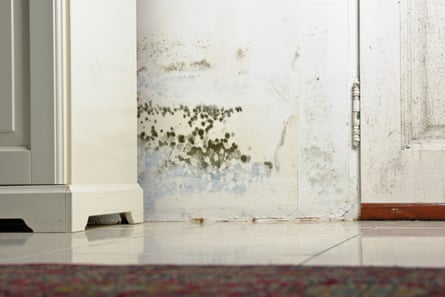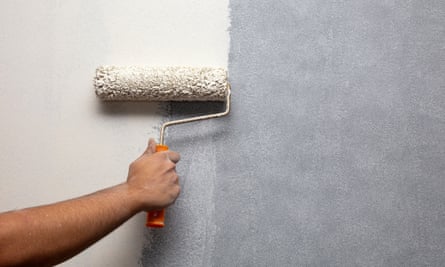
Complaints about mould in social housing have doubled in two years, and with the climate crisis, increased rainfall means the risk of damp and mould to the buildings we live and work in is only going in one direction. Yet it remains a woolly issue that is under-researched and poorly understood, allowing bad advice and expensive mistakes to stalk the landscape. But sorting mould can be relatively simple, if you know how. Here’s our expert guide.
Why do I have mould?
Don’t be so surprised. “Mould is everywhere, all the time,” says Dr Yasemin Didem Aktas, deputy academic director of the UK Centre for Moisture in Buildings (UKCMB), a nonprofit organisation formed by University College London, to improve the way moisture risk is understood and managed in the UK. “We live in a wet country, so we have to expect that we are going to get some mould growth, perhaps in the bathroom, on windows and other cooler areas. But it’s important that we do our best to clean it regularly to stop it building up. It’s very difficult to manage mould in UK buildings and it’s very common.” UKCMB has a handy moisture calculator to help assess the moisture balance in your home, along with guidance for people moving into new homes, and explainer videos for people living in older buildings.
What is a problematic amount?
Patches on walls or ceilings should never be ignored – even if they’re not currently posing a health threat, they’re increasing the spores in your air, encouraging more mould to take hold on any hospitable surfaces. You can also rely on your nose to alert you to problems. Sometimes the mould isn’t visible, says Didem Aktas, “because it is inside the fabric of the building, such as in cavities, or behind heavy furniture. If you can smell it, there is definitely a damp problem, even if it has not manifested on the interior surfaces.”
Can the airborne spores in my home be measured?
The short answer is yes, says Didem Aktas, but it’s complicated. “If you do mould testing anywhere, you will find some mould, but at what level it becomes a problem is something that is not well established yet and therefore hasn’t transpired into policies or practices.” This point is echoed in a new article in the journal Nature by a number of scientists including the UK’s chief medical officer Chris Whitty. Didem Aktas and her team at UCL are working to benchmark these levels, “so that we can give some guidance to the water remediation industry as to when they should be alerted and should be intervening.”
Currently, she says, the many different methods to test mould are often not comparable, “and there is no clear protocol on how to interpret them. There are so many businesses that flourish on this knowledge gap. They go to people’s homes testing and scaremongering, saying the mould is too high, you need £6,000 worth of work. With no proper guidance, you can’t judge if this person is telling you the truth.”
What are the health risks from mould?
“Based on international research data,” says Jouni Lohi, a pathologist at the University of Helsinki, “it is known that living or working in a building with moisture damage can cause asthma, asthma exacerbation, allergic alveolitis and increased susceptibility to respiratory infection.” Other symptoms that have been reported include, “eye, ear, and skin irritation. There are also indications of a link between moisture damage or microbial exposure to neurological symptoms and fatigue.” He says that those with pre-existing respiratory conditions may be at a higher risk, but “possible risk is present across all age groups.” He recommends that if you have any symptoms related to these conditions, it is worth identifying and dealing with mould growing in your home or workplace.
How do I stop the mould?
Cleaning mould and repainting won’t make it go away for ever. You need to find and address what is causing it to flourish in certain areas. It could be one or a collection of factors that are tipping the moisture balance unfavourably. “One of the things that trigger it in our homes is excess moisture condensing on cold surfaces, making them susceptible to mould growth,” says Didem Aktas. Some sleuthing will be necessary to figure out why there’s too much water vapour floating about. Is there too little ventilation? Do you open windows or use extractor fans when cooking, showering or drying clothes? Or there may be water seeping somewhere in your home, leaking from a pipe under the floorboards, through a damaged roof or chimney stack. “Pointing is very important,” says Didem Aktas, “because most of us live in masonry homes and one of the main pathways of moisture into the building fabric is if the mortar joints are damaged or eroded.” Faulty guttering is another potential culprit, causing external walls to become saturated. There is also a slim chance that damp might be rising from the ground up the walls, which usually creates a tell-tale water mark around the damp patch. This can mean a new damp proof course is needed, which is expensive and disruptive, so try measures to rule out condensation – a more common cause – first.
Will increasing insulation help?
While boosting insulation will reduce the amount of cold surfaces for water vapour to condense on, and help keep your home warmer, it can also decrease airflow and trap water in the home. David Prince, a damp specialist at Abbott Property Care, recently encountered a bungalow that didn’t have a damp problem until a government grant enabled the owners to install extra loft insulation. Soon after its installation, water started dripping from the ceiling. The new layer, he says, “stopped the breathability of the building and condensation was occurring between the new insulation laid on top of old insulation.” The motto when retrofitting energy-saving measures, says Didem Aktas, is “no insulation without ventilation. Air tightness is important when trying to improve the energy efficiency of our homes – we don’t want the air exchange between indoors and outdoors to be very high because then you have to heat fresh air constantly.”
How can I ventilate without letting the cold in?
Retrofitting trickle vents above windows will supply you with a small, steady stream of fresh air, but while they will help reduce condensation, they will let in tiny cold drafts in winter (although a lot less than opening a window). Extractor fans are more effective for particularly wet rooms such as bathrooms and kitchens, but these can also let in drafts. The good news is that, depending on the model, you may be able to retrofit yours with a backdraft shutter that closes when the fan is not in use. Meanwhile, progress in energy-saving technology means “you can now get heat recovery ventilation where the air that is taken inside to replace the moist air is heated by the moist air going out,” says Didem Aktas. These are relatively quiet, inexpensive and in their simplest version, as easy to install as an extractor fan. Journalist Sue Wheat, who blogs for Ecologist about converting her Victorian house into an ecohome, had some Kair versions fitted, which have sensors that switch them on when humidity reaches levels that enable dust mites and mould to flourish. They are energy efficient, recover 86% of the heat from the outgoing air and mean that her windows, which used to be streaming wet on cold mornings, now stay dry. The single units currently retail at £286.

Do dehumidifiers help?
The experts I have spoken with do not tend to recommend these – largely because they don’t address the core problem. But if you’re stuck in an overpopulated building or your landlord won’t install ventilation or seek out the source of the damp, these machines can help mitigate the moisture imbalance. They come in many shapes and sizes and collect water from the air in a tank that needs manually emptying when full. Realistically, you can’t have one in every room, making noise, taking up space, using electricity all the time, but if you need to switch one on for a couple of hours when your laundry is hanging out to dry, says Prince, “as opposed to putting all that moisture in your air, I think that’s worth looking at.”
Will turning the heating down help with condensation?
Cold houses will be more likely to have condensation, says Didem Aktas. “When the air is warmer, its capacity to hold moisture increases, but when it’s cooler the moisture has to find other places to hold on to.” Plus the cold walls will become even colder, inviting more water to condense on them.

How do you clean mould?
Make sure you don’t disturb the mould with a brush or dry cloth as you’ll disperse the spores. You can’t just paint over it without killing it first, says Richard Thomas, group sales and operations manager at Rabart Decorators Merchants, who has rectified mouldy walls in damp churches, listed buildings and prefab social housing. “Some people use bleach diluted in water,” he says, “which is fine, but messy, and not quite as effective on walls.” You’re better off, he says, using a mould spray that contains a biocide such as DDAC – about 1 or 2%. As with bleach, you don’t want to inhale it, get it on your skin, expose pets to it or pour it into a river. But as long as you keep the window open while using it, take precautions commensurate to how big an area you’re working on, and avoid long-term exposure, Thomas doesn’t see it as a huge risk. In lesser amounts, he says, biocides like this “go into hand gels, soaps and antibacterial products. Wipe off the excess, allow it to dry and then it’s as simple as using two coats of paint and will prevent mould growth recurring.”

What are the best anti-mould paints?
First, beware anti-damp paints, which are designed to stop water coming through the wall and will likely trap moisture in the wall. Older brick or stone houses need to breathe, says Thomas. “You want to maintain the permeability so you always want a product that describes itself as breathable or vapour permeable.” This includes avoiding those ultra durable and wipeable paints containing vinyl.
When it comes to anti-mould paints, he says, “there are lots on the market of varying degrees of success. All paint contains a biocide which stops it going off in the can. Products that describe themselves as anti-mould would have a higher percentage. It doesn’t prevent the problem of the moisture, it prevents the manifestation of the mould, if you get the right paint. I have been in some very poor quality accommodation that’s been redecorated appropriately, and all the moisture is still there because no ventilation or insulation has been added. But what you won’t get is the mould. Older brick and stone buildings tend to have more moisture in the walls than modern cavity wall buildings anyway.”
Thomas says that almost all the leading trade paint manufacturers have anti-mould or mould inhibiting paints, including ranges by Zinsser, Crown Trade Paint and Dulux . If you’re new to this, he recommends asking an independent paint merchant for advice. “There are lots of companies out there that make it sound incredibly complicated, because it is their business to come in and rectify these issues. But really, it’s about treating the area that’s affected by redecorating it in a more suitable way. And then in the long-term maintaining adequate and sensible ventilation.”

How can I stop mould in my wardrobe?
When wardrobes are full, air struggles to circulate, and when fitted against a cold wall, damp can cause your clothes and shoes to go off like an old bit of cheese at the back of the fridge. Prince says that there are insulating products, “that you can stick on the back wall yourself; usually foam based, just to take the cold edge off.” There are also disposable dehumidifying sachets that, he says, “collect water and then you disregard them.” He also recommends cordless mini-dehumidifiers that use silica crystals to absorb the water. “After about three to four weeks, when the panel on the front changes colour,” says Prince, “you take it out and put it on the charger overnight and it dries it out again.”
What rights do renters have if mould appears in their homes?
“It depends on the cause of the mould,” says John Gallagher, principal solicitor at the charity Shelter. “Where the mould is caused by disrepair or the property is unfit for habitation – for example, as a result of damp or condensation caused by poor insulation or faulty heating or ventilation systems – then it is the landlord’s responsibility to fix it, and it is important that tenants let their landlord know about the problems as soon as possible.” However, as it’s not always immediately obvious what the cause of damp is, expert advice may be needed. “Sometimes the mould may be put down to the tenant not ventilating the home correctly and in those cases the landlord may not be responsible.”
When should a landlord step in/pay for repairs to fix a mould problem?
Once a landlord is made aware of the issue they should carry out repairs within a reasonable period of time, says Gallagher. “What is reasonable will depend on the specific circumstances, but where there is a serious risk to the health of the occupiers, the works should be done urgently.” Landlords for social housing have the same responsibilities as private ones, but, “social landlords may have internal policies relating to timescales which they should adhere to.”
If the mould is really bad and the property is unfit for habitation, says Gallagher, “a person may be classed as homeless and in this case they could make a homeless application to the council.” If they fall into the “priority need” category, because of having children or health complications, they could be entitled to emergency accommodation. “Anyone worried about mould causing dangerous conditions in their home can come to Shelter for help and advice.”



